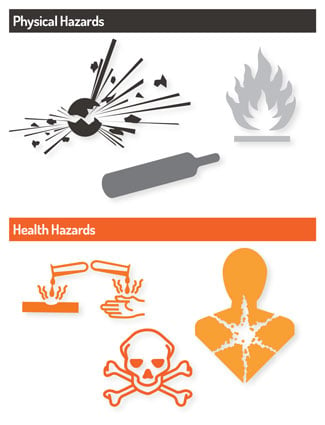Hazardous Chemicals Overview
03
February,
2023
3 MINUTE READ

In the eyes of OSHA, hazardous materials run the gamut from household cleaners to deadly gasses. Effects can range from mild skin irritation to cancer and organ damage. What's more, hazardous chemicals can be found in nearly every industry, including manufacturing plants, healthcare labs, and construction sites.
To that end, it's important that workers understand what classifies as hazardous materials and how to work safely with toxic materials-no matter the hazards present.
What Defines a Hazardous Chemical?
29 CFR 1910.1200, OSHA's regulation that governs the labeling of chemical hazards in the workplace (more commonly known as HazCom 2012), defines "hazardous chemicals" as the following:
"Any chemical which is classified as a physical hazard or a health hazard, a simple asphyxiant, combustible dust, pyrophoric gas, or hazard not otherwise classified."

These hazards are generally broken down into two main categories: physical hazards and health hazards. The "physical hazard" and "health hazard" categories are included in a popular international standard for chemical classification and labeling called the Globally Harmonized System (GHS). The other hazard types listed in that definition were added by OSHA, to fill the gaps in the international standard.
Physical hazards include fire hazards (including combustible liquids and flammable materials), explosion hazards (including compressed gas and explosives), and reactive hazards (including organic peroxide and unstable materials).
Health hazards, meanwhile, fall into two categories: Systemic Effects (including carcinogens, corrosive materials, and irritants) and Target Organ Effects (including neurotoxins and respiratory toxins). In order to pose a health hazard, significant evidence (such as at least one study) must indicate that exposure may have acute or chronic health effects.
The severity of these hazards is reflected in a numbered category. Category 1 contains the most severe hazards (such as propane, a flammable gas), and the category numbers increase as the severity of each hazard decreases. Different hazard classes have different numbers of categories.
These hazards, ingredient information, and more details about a given chemical are communicated on a Safety Data Sheet (SDS), required in the HazCom 2012 standard. Some of those details are also required to appear on a label that is placed on the chemical's container.
OSHA has also issued an advisory guide for hazard determination to help employers understand and comply with HazCom 2012 regulations. The guide assists employers with determining hazards, selecting chemicals, and analyzing data.
Dangerous Chemical Consequences
It's vital to wear proper personal protective equipment (PPE) while working around hazardous chemicals. OSHA's general PPE requirements for most workplaces can be found in 29 CFR 1910.132. Employees who don't comply with these regulations may face severe consequences when working with dangerous chemicals.
- Skin irritation: If employees aren't wearing the appropriate PPE and come into contact with hazardous materials, they may experience rashes, burns, skin irritation, and more.
- Respiratory damage: When employees work in areas that lack proper ventilation or don't wear respirators, they may be exposed to fumes from hazardous chemicals. This can result in immediate illness or even death, and in the long term, may lead to lung cancer or other respiratory illnesses.
- Burns: Workers may be severely burned when they don't wear proper PPE. Explosive chemicals may trigger blasts in a facility, and flammable chemicals may catch fire if not properly handled or stored.
Solutions for Working with Hazardous Chemicals
It is vital that employers and employees do all they can to prevent catastrophic events around dangerous chemicals. This can be done through a combination of education, proper PPE, and signage that alerts workers to nearby hazards.
Employers should be up-to-date and in compliance with OSHA's HazCom 2012 regulations. The rules help employees understand the hazards posed by the chemicals they work with, including handling and storage guidelines, firefighting measures, exposure controls, and more. Request Duralabel free Best Practice Guide to HazCom 2012 Labeling for detailed information.
Chemicals may also be under heavier scrutiny than before, following the passage of the Frank R. Lautenberg Chemical Safety for the 21st Century Act, signed into law on June 22, 2016. Some chemicals may be tested and analyzed by the Environmental Protection Agency for the first time ever, with potentially stricter requirements for labeling chemicals that pose risks to human health and the environment.
Proper PPE is often necessary when working around dangerous chemicals. You may need to protect your workers from head to toe with protective gear, including respiratory protection, as well as protection for the hands, feet, face, and more. Let employees know when PPE is required with clear signage. Custom labels such as those made by DuraLabel industrial label and sign printers can help you develop effective visual communication. Duralabel carries more than 50 specialty supplies suited to industry- and application-specific uses. Download our free Safety Data Sheets Guide for a comprehensive resource.
RELATED RESOURCES

Available Fault Current
The National Electric Code, or NEC, requires that equipment be marked with the available fault current, and ...
Read
ANSI Cutting Standard
ANSI Cutting Standard The American National Standards Institute (ANSI) has updated its hand protection ...
Read
QHSE
Quality, Health, Safety and Environment Management (QHSE) generally refers to a management operation mode ...
Read.png)


